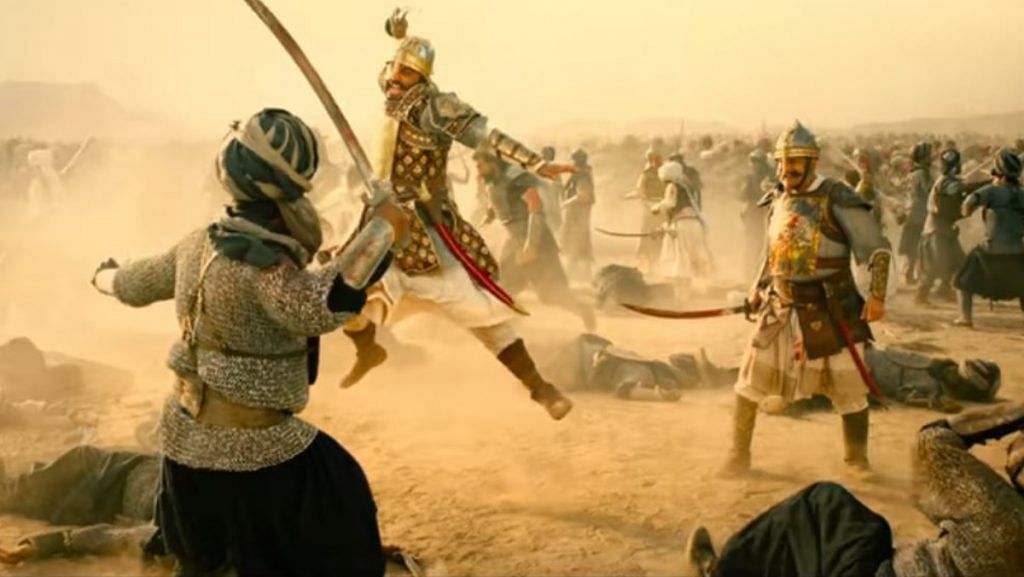There is a scene in Panipat, Ashutosh Gowariker’s movie about the Third Battle of Panipat, in which Najib-ud-Daula of the Rohillas is trying to persuade Nawab Shuja-ud-Daula of Awadh to support him and Afghan king Ahmad Shah Abdali against the Marathas. He offers him written confirmation from Abdali that if they win, the nawab would be made wazir of Hindustan. Just before, an emissary from the Marathas’ side had also offered him the same post. While watching this horse-trading that is not unlike what has happened in Maharashtra recently, one is struck by the fact that history does, in fact repeat itself.
The other interesting thing about the scene is that Najib-ud-Daula plays the Muslim card – one Muslim must support another when push comes to shove. On the opposing Maratha side, Peshwa army commander-in-chief Sadashiv Rao Bhau (Arjun Kapoor) is clear that no one qaum is better than the other, and makes a statement of pointing out that their consolidated army is a multifaith one. (A key person in this army is, in fact, Ibrahim Khan Gardi, who became part of the Peshwa’s army when the Marathas defeated the Nizam of Hyderabad and displays great valour and loyalty to the Marathas in battle.)
While director Gowariker does make some efforts to balance the portrayal of Marathas and Muslims, it is almost as if only the Muslims on the Maratha side are good guys. The portrayal of Ahmad Shah Abdali (Sanjay Dutt), though far more palatable than recent Bollywood blockbusters have shown Muslim rulers of Hindustan (think Ranveer Singh as Alauddin Khilji), still paints him as the looter and plunderer, while Sadashiv and the Marathas are going to battle not for the throne, but to protect a unified Hindustan. This when, as one of the Marathas says in the film, what is a unified Hindustan? He’s not wrong — in 1761, there were Marathas and Rajputs and Sikhs and Mughals and a whole bunch of smaller players, and they were all looking to expand territorially, so why are the Marathas portrayed as somehow better?
Also read: Hotel Mumbai review: The horror of 26/11 terror attacks deserves a better film
The Marathas are introduced in a beautifully choreographed and sanitised battle sequence, while Abdali’s first scene, a brutal knife fight in his own court, comes spattered with blood and gore. Abdali is portrayed as a one-note character, every scene showing him is accompanied by menacing music, and Dutt portrays him with a one-note menacing expression interspersed with roaring when he is upset. At one point, Sadashiv’s wife, Parvati Bai (Kriti Sanon), even calls Abdali a rakshas (demon). Then there is the fact that the Marathas are shown as family men, with loving wives and mothers, while the Afghan side has no female characters at all. It is clear what the film is meant to say — and if it’s still not clear, two of the film’s three utterly forgettable songs (music by Ajay-Atul) are Mard Maratha and Jai Shiva. Despite the fact that everyone knows the Marathas decisively lost this battle, in this movie, they are portrayed as its only real heroes.
But frankly, the one-sidedness is unsurprising. And Gowariker does try to soften the demonic image of Abdali, even if it is via his letter to the Peshwa expressing his admiration for the Marathas’ valour despite their defeat (the admiration has historically been recorded, in fact). And the scene in which Sadashiv asks Parvati to promise him that if he dies, she will not commit sati, is a refreshing departure from recent offerings from Bollywood.
By and large, the film portrays the Third Battle of Panipat in terms of the facts, and the actual battle is restricted to only some of the last hour. Most of the movie is about the political intrigues preceding the battle, the romance between Sadashiv and Parvati and the tension within the Peshwa’s (an underused and competent Mohnish Behl) own family — his wife Gopika Bai (Padmini Kolhapure) is worried that Sadashiv will usurp the throne. And when the battle does begin, the war strategies make for gripping visuals — barring the painfully slow slow-motion scene of Sadashiv falling to his death.
The film, though three hours long, is largely well-paced and good-looking. Neeta Lulla’s costume design, Nitin Chandrakant Desai’s production design and C.K. Muraleedharan’s cinematography work well to give a sense of the different architectural styles from Pune to Kandahar, but some of the CGI looks amateurish. Arjun Kapoor is predictably personality-less as Sadashiv, and actually, the best performance among the three leads comes from Kriti Sanon. Parvati Bai has a meaty role in the movie, and Sanon, though a little too preppy and 21st century, does her best to dig into the role’s many emotions — and get the Marathi right.
Ultimately, Panipat is a serviceable, predictable retelling of the battle, but it does not tell you anything new or try anything out of the box in its treatment.
Also read: Movie-streaming website MUBI comes to India with a bang, and it’s not just another Netflix
